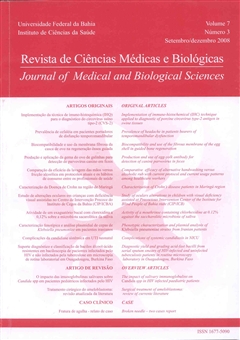Phenotypic characterization and plasmid analysis of Klebsiella pneumoniae strains from Iranian patients
DOI:
https://doi.org/10.9771/cmbio.v7i3.4471Keywords:
Klebsiella pneumoniae - ESBL strains- Plasmid profiling- Tehran Hospitals, Nosocomial infections- Drug resistance.Abstract
Local knowledge of antimicrobial susceptibilities of Klebsiella pneumoniae is important for implementation of effective hospitals anti-infective policies. One hundred isolates of K. pneumoniae collected from 3 different hospitals in Iran during 2004 were screened for their susceptibilities to thirteen different antibiotics using disk diffusion test and macro broth dilution assay. Isolates were then subjected to restriction endonuclease analysis of plasmid DNA. All isolates were susceptible to imipenem. The rates of resistance to other antibiotics were in the following order: amikacin (10%), piperacillin-tazobactam (%2), ciprofloxacin (20%), ceftizoxime (14%), cefexime (31%), ceftazidime (28%), cefotaxime (33%), nalidixic acid (32%), cephalexin (32%), gentamicin (30%), nitrofurantoin (31%) and piperacillin (66%). The production of extended spectrum betalactamase (ESBL) hydrolyzing ceftazidime and cefotaxime was detected in 54% of isolates. Of 100 isolates tested, 67 harbored plasmids and the remaining lacked any plasmid. Though the prevalence of ESBL phenotype in Iran is higher than western countries, it is close to figures reported from the region. Evidences for outbreaks with certain isolates of K. pneumoniae were found by restriction endonuclease analysis of plasmid DNA. This technique also showed the persistence of infections in the urinary tract of several patients.Downloads
Download data is not yet available.
Downloads
Published
2008-02-02
How to Cite
Feizabadi, M. M., Farahani, A. S., Rahmati, M., & Asadi, S. (2008). Phenotypic characterization and plasmid analysis of Klebsiella pneumoniae strains from Iranian patients. Journal of Medical and Biological Sciences, 7(3), 273–279. https://doi.org/10.9771/cmbio.v7i3.4471
Issue
Section
ORIGINAL ARTICLES
License
The Journal of Medical and Biological Sciences reserves all copyrights of published works, including translations, allowing, however, their subsequent reproduction as transcription, with proper citation of source, through the Creative Commons license. The periodical has free and free access.


